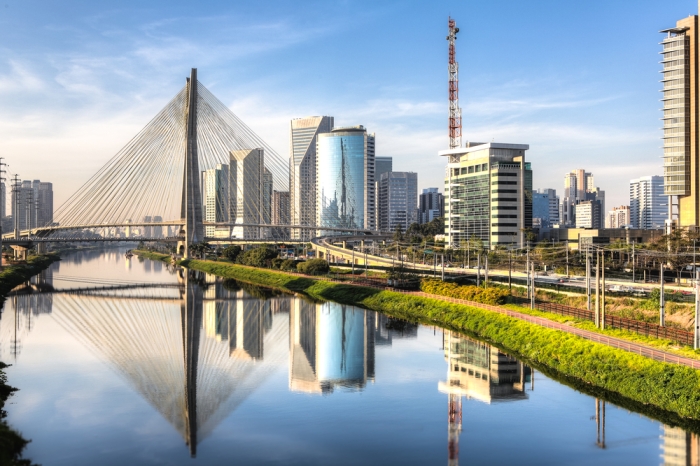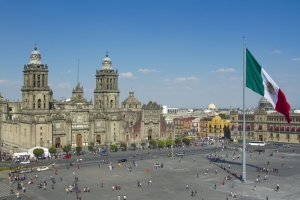GRT Guest Blogger, Geovanny Vicente Romero is a lawyer, political scientist, and university professor. He specializes in public policy and public administration, with several years of experience in the public sector.
Large, bustling cities like Sao Paulo, Mexico City and Lima contribute to the growing economic development and rapid urbanization of Latin America and the Caribbean. In fact, the 80 percent urbanization rate of this region nearly equals that of high-income countries. However, the infrastructure and service networks throughout Latin American and Caribbean cities need a sustainable overhaul to manage their growth in harmony with the environment, the traditional source of this region’s wealth.
The metropolitan city center distinguishes itself as both the home of commercial activity and seat of local government. As people continue to seek out more prosperous lives and economic opportunities in cities, investing in sustainability has become more important than ever. Here are four Latin American cities that are strategically investing in their sustainable future, with lessons learned that can apply to many cities across the region.

1. Rio de Janeiro, Brazil – Rio de Janeiro is not only known for its festive Carnival and beautiful beaches, but Rio is also home to Latin America’s first smart city inaugurated in 2012: Buzios Smart City Project. This initiative is focused on new models of telecommunication, public lighting, smart buildings, sustainable sources of electricity, efficient transportation, sustainable tourism, and social integration. Buzios is a city with all of its networks automated and functioning within a synchronized system.
In 2013, during the Smart City Expo World Congress, Rio de Janeiro was awarded Smart City of the Year. Furthermore, one of the leading technology companies IBM has created a customized Operations Center for Rio using the most advanced computer systems to monitor the entire city and coordinate an immediate response to extreme weather events and city services such as public safety, traffic patterns, and sanitation.
 Medellín, Colombia – In just two decades, Medellín has transformed itself from one of the world’s most dangerous cities to one of the world’s most sustainable cities, winningmany awards for its advanced transportation networks. This Colombian city has made smart and sustainable development a priority, investing in innovative urban development projects targeting more economic and social integration. Medellin intends to become Latin America’s capital of innovation in 2021, with its Medellín Innovation project. This city ranks above the world’s average in public services, as it has taken advantage of every opportunity to upgrade technology and generate efficiencies for its citizens, especially with regard to transportation networks and traffic. Medellín has one of the world’s quickest commuting times, due to adopting innovative transit management found often in the developed world, including road sensors, cameras, traffic advisories, and traffic lights that show the speed of vehicles as they pass. In 2016, Medellín has revamped its Tranvia streetcar after more than 50 years of it being out of service. These new electric trains are integrated within the city’s transportation nodes to encourage citizens to use mass transit as a long-term strategy to combat climate change.
Medellín, Colombia – In just two decades, Medellín has transformed itself from one of the world’s most dangerous cities to one of the world’s most sustainable cities, winningmany awards for its advanced transportation networks. This Colombian city has made smart and sustainable development a priority, investing in innovative urban development projects targeting more economic and social integration. Medellin intends to become Latin America’s capital of innovation in 2021, with its Medellín Innovation project. This city ranks above the world’s average in public services, as it has taken advantage of every opportunity to upgrade technology and generate efficiencies for its citizens, especially with regard to transportation networks and traffic. Medellín has one of the world’s quickest commuting times, due to adopting innovative transit management found often in the developed world, including road sensors, cameras, traffic advisories, and traffic lights that show the speed of vehicles as they pass. In 2016, Medellín has revamped its Tranvia streetcar after more than 50 years of it being out of service. These new electric trains are integrated within the city’s transportation nodes to encourage citizens to use mass transit as a long-term strategy to combat climate change.
 Mexico City, Mexico – Mexico City’s investments in conservation initiatives including smart building construction and design, digitization of government services, and air quality improvement have earned it a reputation as a smart and sustainable city. For the last 20 years, Mexico City has been addressing the high levels of smog in its air by upgrading many of the city’s vehicles with more favorable emission standards, thanks in part to the German Government’s International Climate Initiative (IKI) that aims to reduce CO2 emissions. One example is a technology called Prosolve 370e, created as part of the design of Mexico City’s Manuel Gea Gonzalez hospital, neutralizes air pollution produced by 1,000 cars each day. In 2013, Mexico City received the City Climate Leadership Award because of its policies aimed at improving air quality. Mexico City’sProgram to Improve Air Quality in the Metropolitan Region of the Mexican Valley (PROAIRE) has set a goal to reduce 5 million tons of greenhouse gasses by 2020.
Mexico City, Mexico – Mexico City’s investments in conservation initiatives including smart building construction and design, digitization of government services, and air quality improvement have earned it a reputation as a smart and sustainable city. For the last 20 years, Mexico City has been addressing the high levels of smog in its air by upgrading many of the city’s vehicles with more favorable emission standards, thanks in part to the German Government’s International Climate Initiative (IKI) that aims to reduce CO2 emissions. One example is a technology called Prosolve 370e, created as part of the design of Mexico City’s Manuel Gea Gonzalez hospital, neutralizes air pollution produced by 1,000 cars each day. In 2013, Mexico City received the City Climate Leadership Award because of its policies aimed at improving air quality. Mexico City’sProgram to Improve Air Quality in the Metropolitan Region of the Mexican Valley (PROAIRE) has set a goal to reduce 5 million tons of greenhouse gasses by 2020.
- Santiago de los Caballeros, the Dominican Republic- The second largest city in the Dominican Republic, home to 9 percent of the country’s population, is also the fourth largest city in the Caribbean, both in terms of its population and its economy. Santiago has launched an action plan called Santiago de los Caballeros: Sustainable City, with support from the Inter-American Development Bank (IDB) Emerging and Sustainable Cities Initiative (ICES). As part of this plan, national and local authorities, as well as the Santiago Strategic Development Council (CDES), strive to address urgent challenges to the sustainability of the city and its environs. Among the issues that this project will address include climate change, urban development, economic competitiveness, public safety, and mobility. Furthermore, a national 911 system for emergencies will begin operating in Santiago in 2016, with monitoring cameras and emergency rescue units throughout the city.

San José de las Matas, a town within Santiago and the largest municipality in the Dominican Republic, is considered one of the cleanest cities in the country. San Jose de las Matas disposes of 95 percent of the town’s solid waste produced daily, sorting the garbage into organic and inorganic sources, and applying its recycling policy through a program known as Zero Waste. This program is supported by international organizations. Today, San Jose de las Matas serves as an example for other cities to adapt its best practices for converting organic waste into organic fertilizer through composting, and using this material for its agricultural output.
These four cities have strategically invested in conserving resources and upgrading infrastructure to ensure a more sustainable future in the face of rapid development. There are many more smart city examples throughout Latin America and the Caribbean incorporating both top-down and bottom-up solutions to sustain the region’s urbanization. Can you describe others? Tell us about them in the comments below.
Geovanny Vicente Romero @geovannyvicentr
Geovanny lives in Washington, D.C. He is a lawyer, political scientist, and university professor. He specializes in public policy and public administration, with several years of experience in the public sector. He holds degrees in Administrative Law, Criminology, and Prisons Law. Geovanny regularly speaks at conferences on subjects of his expertise, including Public Administration, Civil Service, and Open Government. He is the Director of the Center for Public Policy, Development, and Leadership of the Dominican Republic (CPDL-RD), and the recipient of the Dominican Republic’s Provincial Youth Award in Professional Leadership granted by the Dominican Presidency and Ministry of Youth.
No hay comentarios:
Publicar un comentario